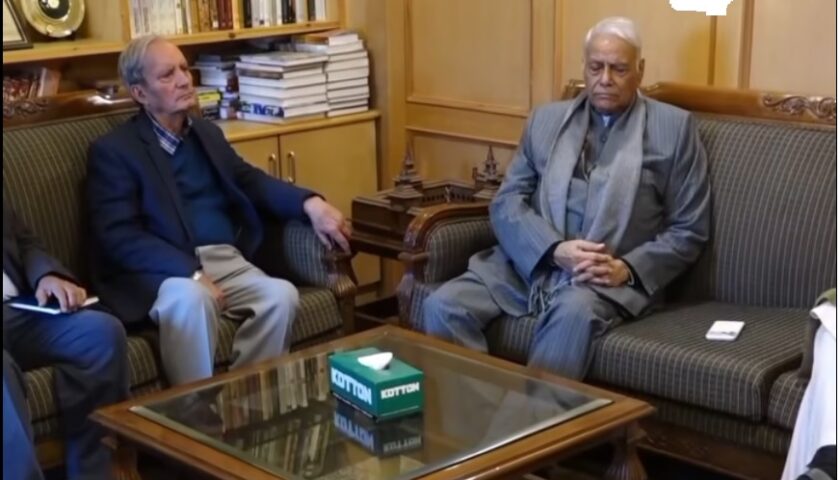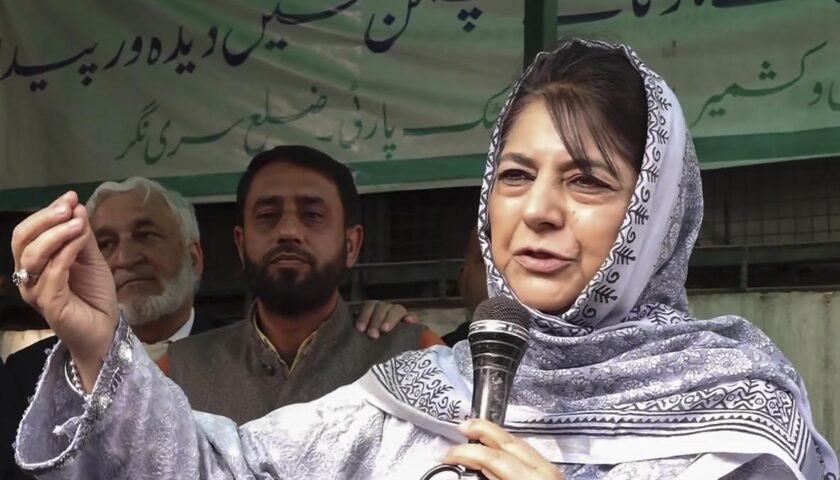Mirwaiz Umar Farooq Appeals to PM Modi & Amit Shah to Release Kashmiri Prisoners — A Humanitarian Call
By: Javid Amin | 10 October 2025
In a powerful sermon at Jamia Masjid, Mirwaiz Umar Farooq urges the Centre to free long-imprisoned Kashmiris—drawing both hope and critique.
On a day heavy with symbolic resonance, Hurriyat Conference Chairman and Kashmiri cleric Mirwaiz Umar Farooq appealed directly to Prime Minister Narendra Modi and Home Minister Amit Shah to release Kashmiri prisoners who have spent years or even decades behind bars. Speaking during the weekly Friday congregation at Jamia Masjid, Kashmir’s spiritual heart, he framed the call as both humanitarian and democratic, asserting that such a gesture could begin a path toward reconciliation.
This article examines what Mirwaiz said, who the prisoners are, historical and legal context, reactions, challenges to the plea, and what it means politically in the current climate.
What Mirwaiz Asked: Key Highlights
Addressing a packed congregation, Mirwaiz delivered remarks that were stern yet laden with emotional appeal. His core points:
-
Humanitarian grounds: He argued that many detainees have undergone severe health deterioration, endured long trials, and suffered separation from family. He said continued imprisonment is not just injustice, but cruelty. The Tribune+2Uniindia+2
-
Democratic and moral legitimacy: He urged the government to view the issue not through a narrow law-and-order lens but from a broader, more humane perspective—appealing to the conscience of the nation. Uniindia+2Kashmir Observer+2
-
Symbolism and history: He referenced October 10 as the date when his father, the earlier Mirwaiz Farooq, was arrested in 1965—a historical echo he used to underscore how political incarceration has persisted across generations. Uniindia+2knskashmir.com+2
-
Names of detainees: He named several high-profile persons he sees as emblematic of the Kashmir cause: Shabir Shah, Yasin Malik, Asiya Andrabi, Aftab Shah, Engineer Rashid (Sheikh Abdul Rashid), and Mehraj Malik. The Tribune+2Uniindia+2
-
Appeal to win hearts: He said that releasing detainees would help win the goodwill of Kashmir’s people—a move he views as essential to reconciliation and restoring trust. Uniindia+2Kashmir Observer+2
In his words:
“Hundreds of Kashmiris, young and old … continue to languish in jails for years and even decades, many under draconian laws, merely for holding dissenting views.”
“Their mental and physical health has been gravely affected, and their families continue to suffer immensely.”
Mirwaiz appealed not only for release but for a humanitarian review of detentions—a reconsideration of cases, especially for those whose trials are protracted or whose health is failing. knskashmir.com+2Uniindia+2
Who Are the Prisoners Named — A Closer Look
Mirwaiz’s naming of specific detainees is not purely symbolic—these individuals are central figures in Kashmir’s political and protest movements. Understanding their backgrounds helps grasp why the appeal reverberates. Some caveats: legal status, charges, and detention contexts differ for each, and many cases are contested in court.
Shabir Ahmad Shah
Also known as Shabir Shah, he is a veteran Kashmiri separatist leader and founder of the Jammu & Kashmir Democratic Freedom Party (JKDFP). Over the decades, he has been jailed many times, accused in various cases including alleged terror financing, money laundering, or links to unlawful activities.
He has been a symbolic figure of Kashmir’s dissent movement. Reports have surfaced about his deteriorating health in prison in recent years.
Asiya Andrabi
Asiya Andrabi is a well-known separatist figure and founder of Dukhtaran-e-Millat, a female-led Kashmiri group advocating for separation from India. She has been arrested multiple times, booked under charges including sedition and the Unlawful Activities (Prevention) Act (UAPA).
Her health, detention longevity, and legal limbo have often been highlighted by human rights activists.
Yasin Malik
Though Mirwaiz’s speech mentions Yasin Malik in some reports, not all versions of the appeal directly list him. Malik is a prominent former separatist leader (JKLF), convicted in United States and Indian courts on terror funding charges.
Engineer Rashid (Sheikh Abdul Rashid)
Engineer Rashid is a former Lok Sabha MP representing North Kashmir. He has faced legal challenges and is currently in jail.
Mehraj Malik
Mehraj Malik is a former MLA, reportedly associated with the Aam Aadmi Party (AAP) in J&K. He has been detained under undisclosed charges.
Aftab Shah
Aftab Shah, also identified as Shahid-ul-Islam, is another detainee cited in media reports.
It is crucial to note that each of these detainees is under different legal regimes—some under UAPA, others under Public Safety Act (PSA), some facing trial, some under preventive detention. Mirwaiz’s appeal doesn’t seek a blanket amnesty but a humanitarian review and selective release where possible, especially for those suffering or long detained.
Historical & Legal Backdrop
Mirwaiz’s appeal resonates precisely because the issue of political detention is deeply embedded in Kashmir’s modern history. Preparing to understand current possibilities means revisiting past practice and legal contours.
Historical Tradition of Political Detention in Kashmir
Since the 1950s onward, Kashmir has seen recurrent periods of political crackdowns: arrests of dissenters, Islamists, separatists, and protest leaders. The use of preventive detention, special orders, and public safety laws became endemic in turbulent years.
Mirwaiz used this continuity in his speech: he recalled his father’s 1965 arrest (on October 10) to draw a symbolic line from past grievance to contemporary injustice. Uniindia+1
Post-2019 Changes and Intensified Detentions
After the abrogation of Article 370 in August 2019, and the reorganization of Jammu & Kashmir as a Union Territory, there was a significant tightening of security and curbs on protest activity. Many leaders and activists were detained or placed under house arrest. Mirwaiz himself was kept under house detention for over four years until September 2023.
The 2019 move also changed legal and administrative oversight, making central laws more directly applicable in J&K. Thus detainees there are subject to the same central statutes (e.g. UAPA, PSA) as anywhere else in India—removing many previous layers of local legal protection.
Legal Regimes: UAPA, PSA & Preventive Detention
-
Unlawful Activities (Prevention) Act (UAPA): A central law designed to combat terrorism and secessionist activity, often used to keep suspects in prolonged detention before or during trials. Many Kashmiri detainees are booked under UAPA provisions.
-
Public Safety Act (PSA): J&K’s special public safety statute, allowing preventive detention without trial for extended periods (often 6 months, extension possible). Historically controversial for its broad scope and lack of effective judicial oversight.
-
Preventive Detention Laws & Remand Extensions: Many detainees are held on remand for long periods, or under repeated extension orders, sometimes without clear public disclosure of evidence.
One of the persistent criticisms is that many detainees are held not because they have been convicted, but because trials are delayed or never completed. Mirwaiz’s argument emphasizes precisely this—cases dragging on, health declining, families suffering.
Judicial and Human Rights Calls
Over years, human rights groups, lawyers, and families have petitioned courts and human rights commissions to examine detention practices, expedite trials, grant bail, and ensure fair procedures. Some courts have intervened in individual cases, ordering medical examinations or bail in special circumstances. But systemic release or broad relief has rarely been granted.
International and domestic advocacy groups often cite cases of poor prison conditions, mental health decline, and lack of family access. Mirwaiz’s appeal amplifies these voices from a platform with religious and symbolic resonance.
Reactions, Possibilities & Constraints
Immediate Reactions
The appeal has drawn media attention across local and national outlets:
-
Media reports highlight Mirwaiz’s naming of key detainees and framing of the plea as part of a reconciliation process.
-
Civil society and family groups have expressed support. Many families of detainees say Mirwaiz’s public naming gives new moral weight to their long advocacy. (Reported in local media)
-
Government reaction as of now is muted in public media—no formal statement in response to the appeal has been reported.
What the Government Could Do (or Resist)
Releasing politically detained persons is a delicate proposition for the Centre and state administration. Some potential pathways and constraints:
What the government might do:
-
Selective review and release
Release detainees facing serious health crises, or whose trials are excessively delayed, on humanitarian grounds—perhaps through interim bail, deferred sentences, or formal remission. -
Conditional release or parole
Grant conditional release under obligations (e.g. house arrest, monitoring, reporting) rather than full freedom. -
Case reexamination
Order a fresh review of evidence, remand status, or legality of detention orders. -
Public relations gesture
Use limited release as goodwill gesture to defuse tensions and open engagement channels.
What constraints may block or slow action:
-
Security and political risk perception
The government might argue that releasing some detainees could embolden separatist or militant activity, or be seen as a concession to anti-state elements. -
Legal and judicial constraints
Courts may reject bail or release in serious cases. Some statutes (UAPA, PSA) are stringent and provide narrow scope for judicial intervention. -
Administrative inertia and precedent concerns
Once one high-profile release is made, many others may come forward; this can strain administrative and legal resources, or raise demands beyond what the government wants to concede. -
Opposition politics and optics
Political opponents might frame releases as weakness; the government risks backlash in hardline nationalist circles. -
Proof, evidence and due process
If some detainees’ cases have substantial evidence or credible legal grounds, the government may argue it cannot simply release without respecting due process.
In short: the appeal is morally potent, but politically and administratively fraught.
Political Implications in the Current Kashmir Climate
Mirwaiz’s public appeal doesn’t exist in isolation. It intersects with larger themes in Kashmir politics: legitimacy, dialogue, electoral cycles, and public mood.
-
Test for Omar Abdullah/NC Government
The NC-led government in J&K is under performance pressure. Such an appeal increases expectations that even if central powers hold sway, the local government should advocate for human rights, legal fairness, and act as a bridge. -
Influencing public sentiment & narrative
For pro-Kashmir, pro-reconciliation voices, this appeal shifts the narrative from one of exclusivity to human compassion. It strengthens voices arguing for trust-building gestures rather than merely security responses. -
Pressure on the Centre
If public support or civil society momentum coalesces, the Centre may find it harder to ignore such appeals without appearing harsh or unempathetic on humanitarian grounds—especially in the context of international scrutiny on human rights. -
Opposition vs ruling party crosswinds
Parties in J&K (PDP, Congress, Apni) may leverage this appeal to criticize both the local NC government (for not pressing harder) and the Centre. Meanwhile, the ruling party at the Centre may calculate whether responding helps or harms its national posture on security and sovereignty. -
Engagement vs suppression calculus
The appeal subtly pushes the idea that repressive measures alone cannot sustain legitimacy. It nudges toward political engagement, albeit under heavy constraints.
Risks, Critiques & Blind Spots
No political appeal is beyond critique. Some challenges and criticisms that commentators may raise:
-
Security concerns over certain detainees
Critics will argue that not all detainees named are nonviolent or innocuous; some may be involved in serious or violent acts. Blanket release could be seen as risk to public safety. -
Merit and evidence questions
For many, the state will demand clarity: What does the evidence say? Have trials proceeded fairly? Release without judicial basis may provoke legal backlashes. -
Tokenism vs structural change
Some may see selective releases as symbolic acts that don’t address structural issues: detention backlog, law reform, court delays, prison conditions, legal avenues. Without wider reform, such appeals risk being cosmetic. -
Political opportunism claims
Opponents may accuse Mirwaiz or Hurriyat voices of posturing, especially if electoral or alliance interests are in play. -
Partial release resentment
If only a few high-profile detainees are freed, many families of less famous prisoners may resent perceived favoritism or inequality. -
Legal barriers
Some detention orders might be legally airtight under existing statutes, with little room for executive or judicial override without constitutional change or legislative amendments.
What Would Success Look Like?
If the appeal translates into action, its success might be measured along these dimensions:
-
Release of one or more high-profile detainees, particularly those in poor health or long custody, via bail, parole, or humanitarian remission.
-
Public review/wake-up of similar long-pending cases—government issuing guidelines to speed up trials, review remand durations, grant bail more liberally.
-
Institutional reforms: amendment or oversight in detention laws (PSA, preventive detention rules), improved judicial review, or policy direction on political detainees.
-
Confidence building: families report reduced anxiety, improved access, more open communication between detainees and families, and incremental trust building between government and civil society.
-
Narrative shift: the public discourse shifts to emphasize reconciliation, dignity, and rule of law, rather than solely security or suppression.
Even a modest procedural shift—like a directive for human rights review of long detentions—would be notable.
Bottom-Line: A Moral Gesture, a Political Test, a Bridge or a Mirage?
Mirwaiz Umar Farooq’s appeal is more than a sermon—it is a moral and symbolic challenge to the Indian state. It forces public attention on the human cost of prolonged detention and the trauma borne by individuals and families. In a region where narratives of injustice and identity carry deep resonance, the appeal seeks to reframe detention not as necessary control but as a wound that needs healing.
Whether the Centre responds is uncertain. The government must balance security, political calculations, judicial constraints, and international perception. But refusing to respond entirely risks being seen as insensitivity to suffering—a liability in democratic optics.
For Kashmir, such a gesture has real stakes. It could either be a turning point in restoring trust, or another unfulfilled expectation. If the detainees are not freed, the appeal still forces continued scrutiny—on courts, on prison systems, on accountability itself.
In a contested land where every act signals more than itself, Mirwaiz’s plea sets a moral bar. The question now is: who will dare to step over it?




